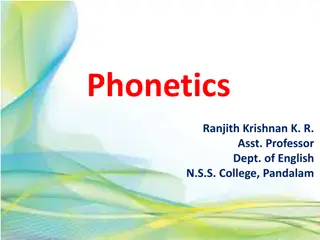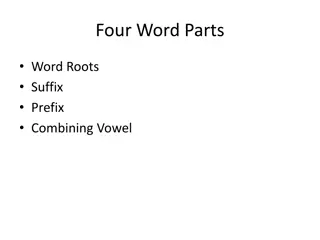Understanding Consonant Clusters in English
Consonant clusters are groups of consonants without vowels in between, found at the beginning, middle, or end of words. They play a crucial role in English pronunciation and word formation, with specific patterns and exceptions to consider. This guide provides insights into different types of conson
3 views • 18 slides
Understanding the Importance and Nature of Syllables
Syllables play a crucial role in speech rhythm, yet their definition and identification can vary among individuals. The nature of syllables, encompassing vowels, consonants, onsets, and codas, can be analyzed phonetically and phonologically. This article explores syllable structures and phonotactics
2 views • 18 slides
Understanding Vowels and Consonants in English Language
The English alphabet consists of 26 letters, with 5 vowels (A, E, I, O, U) and 21 consonants. Vowels are unique sounds produced by opening the mouth without obstructions, while consonants involve partial or complete closure of airflow. Vowels can be further categorized into long and short based on t
6 views • 28 slides
Understanding English Syllables: Phonetics and Linguistics Insights
Explore the concept of syllables in English phonetics and linguistics, learning about syllable formation, examples of mono and disyllabic words, and the role of vowels and consonants in syllable structure. Delve into the essence of syllables as individual sound units within words. Discover more thro
11 views • 8 slides
Mastering the Past Participle in English Verbs
Understand how to form and use the past participle in English verbs, both regular and irregular. Learn the rules for forming regular past participles, including when to double consonants and when to change 'y' to 'i'. Discover examples of irregular verbs and how their past participles are formed. Ex
0 views • 8 slides
Introduction to Syllable Types
Delve into the world of phonetics with this informative content explaining vowel sounds, consonant sounds, and the concept of syllables. Discover the differences between short and long vowel sounds, voiced and unvoiced consonants, and how syllable types can aid in pronunciation. Engage in interactiv
2 views • 31 slides
R-Controlled Vowels Word Lists for Phonics Practice
Enhance your phonics skills with this comprehensive list of R-controlled vowels words. Practice pronouncing and recognizing words like 'farm,' 'chart,' 'fork,' 'storm,' 'nerve,' and more across different slides featuring ar, or, er, ir, and ur word families. A perfect resource for improving reading
0 views • 19 slides
Fun Word Lists for Consonant Blends & Short Vowels
Explore engaging word lists featuring consonant blends and short vowels, including two-letter blends (initial and final), mixed blends, and two & three-letter blends. Enhance vocabulary skills with words like stun, click, floss, loft, crunch, swift, squish, and more!
0 views • 13 slides
Understanding Medical Terminology: Key Components and Usage
Medical terminology is a specialized language used by healthcare professionals worldwide, rooted in Greek and Latin words. It comprises word parts, such as roots, prefixes, and suffixes, which are crucial for forming and understanding medical terms. The combining forms aid in pronunciation and help
2 views • 17 slides
Understanding Dactylic Hexameter in Latin Poetry
Latin poetry employs a rhythmic structure known as meter to enhance meaning and poetic effect. Particularly, dactylic hexameter is a prevalent meter in ancient epic poetry, consisting of six feet predominantly made up of dactyls—a long syllable followed by two short syllables. Scanning dactylic he
0 views • 9 slides
Understanding the Use of A and An in English Grammar
Explore the concept of using "a" or "an" in English based on whether the following word starts with a consonant or a vowel. Learn about consonants and vowels, practice identifying them, and see examples of correct usage. Enhance your grammar skills with this engaging educational material.
1 views • 13 slides
Understanding English Consonant Sounds: A Detailed Guide
This guide delves into the English phonetics and linguistics classification of consonant sounds, emphasizing factors such as place of articulation and manner of articulation. It covers various types of consonant sounds, from bilabial and labio-dental to alveolar, post-alveolar, palatal, velar, and g
1 views • 11 slides
English Pronunciation Class Activities and Examples
This class session covers various pronunciation activities and examples related to sibilant consonants, voiced and voiceless consonants, and conjugation patterns of verbs ending in -s, -z, -ch, -sh, -t sounds. It also includes exercises with verbs ending in -ed for pronunciation practice.
0 views • 6 slides
Guidelines for Forming Singular and Plural Nouns
This collection provides clear guidelines for forming singular and plural nouns, including adding "-s", "-y endings, and "-ies". It also covers exceptions, proper nouns, and tips on pluralizing certain words. Learn when to add "-es", double consonants, or when a false pronunciation might occur.
0 views • 21 slides
Understanding Phonetics: Sounds, Symbols, and Classification
Explore the world of phonetics with a focus on speech sounds, the International Phonetic Alphabet (IPA), organs of speech, and different types of phonetics including acoustic, auditory, and articulatory phonetics. Discover the unique characteristics of English sounds, vowels (monophthongs and diphth
0 views • 13 slides
Understanding Phonological Processes in English Language
Phonological processes involve changes in linguistic sounds over time, impacting language fluency and oral production significantly. EFL students can benefit from knowledge of these processes, like linking, gemination, elision, metathesis, assimilation, haplology, and coalescence, to enhance their l
0 views • 17 slides
Understanding Syllable Types in English Language
Syllables in English are categorized into open and closed syllables based on their endings. Open syllables have an onset and nucleus without a coda, while closed syllables include a coda. Additionally, syllables can be simple (with a vowel or single consonant) or complex (with consonant clusters). T
0 views • 6 slides
Irish Grammar: Past Tense Verbs - Rules and Examples
Learn about forming the past tense of 1-syllable broad verbs in Irish grammar. Understand when to use "h," "d," or "dh" before verbs starting with consonants, vowels, or "f." Discover how to ask questions and form negatives in the past tense, with helpful examples provided.
0 views • 6 slides
Interactive R-Controlled Vowels Word Cards for Phonics Practice
Enhance phonics skills with these interactive word cards focusing on r-controlled vowels. Practice words like "far," "dark," "port," and more in engaging activities featuring ar, or, er, ir, and ur vowel sounds.
0 views • 6 slides
Study of English Phonetic Courses at University of Ben Boulaid Moustafa
Explore the world of English phonetics at University of Ben Boulaid Moustafa, Batna-2, Algeria. Delve into articulatory phonetics, phonology, consonants, vowels, diphthongs, triphthongs, and more. Understand the branches of phonetics and the physical production of speech sounds.
0 views • 49 slides
French Pronunciation Guide: Vowels, Nasal Sounds & Consonants
Explore the intricacies of French pronunciation through the International Phonetic Alphabet (IPA), understanding vowel sounds, nasal vowels, and consonant variations. Master the differences in sound production and learn how to correctly pronounce French words with detailed explanations and visual ai
0 views • 18 slides
Understanding Vowels in English and Arabic
Explore the concept of vowels in English and Arabic languages, including their types, representation, and sounds. Discover the differences between short and long vowels, as well as the unique diphthongs present in Arabic. Learn about nunation and how it is used to indicate indefinite nouns and adjec
0 views • 14 slides
Understanding English Vowels: Sounds and Patterns
Explore the diverse range of English vowels, including pure vowels, diphthongs, back, front, and central vowels. Learn about the articulation points, positions of the tongue, height, and lip rounding to master pronunciation. Dive into the variations in vowel sounds and their classifications.
0 views • 18 slides
Understanding Vowel Sounds: Phonetics and Classification
Explore the classification of vowel sounds in English phonetics by Dr. Prithiviraj Singh Chauhan. Learn about the criteria involved, including tongue and lip positions, to categorize vowels based on articulation and sound production. Discover the cardinal and secondary cardinal vowels and their desc
0 views • 8 slides
Understanding Plural Nouns in English Grammar
Exploring the rules for forming plural nouns in English, from adding "s" to special cases like words ending in "s," "ch," "sh," "x," or "z." Learn how to modify nouns ending in vowels or consonants, as well as irregular plural forms and compound words. Enhance your grasp of English grammar with prac
0 views • 16 slides
Overview of the General American Dialect
The General American Dialect, also known as GenAm, is a widely preferred dialect of English characterized by minor differences in pronunciation compared to regional American accents. It is distinct from Southern, Midwestern, and Northeastern accents and is one of the two global English dialects alon
0 views • 13 slides
Understanding Latin Syllables and Vowel Length Rules
Learn about the division of Latin words into syllables based on vowels, the rules for accent positions, distinguishing long and short vowels through special marks, and recognizing syllables that are always long or short. Explore how Latin vowels are categorized by nature and marked in dictionaries t
0 views • 24 slides
Insights into Xhosa Language and Culture
Xhosa, the second most spoken language in South Africa, is part of the Nguni sub-family of the Bantu languages. It has a rich history, with various dialects and a unique structure based on noun classes and concords. The language has undergone significant transformations, such as being written in a R
0 views • 17 slides
Exploring the Unique Features of the Polish Language
Polish, a West Slavic language, boasts a distinctive alphabet with diacritics like ogonek and kreska. Nasalized vowels and palatal consonants set Polish apart, showcasing its rich linguistic heritage from Proto-Balto-Slavic to PIE roots.
0 views • 13 slides
Common Pronunciation Challenges in Spanish for English Speakers
Pronunciation challenges for English speakers learning Spanish include the addition of schwa sound, substitution of Spanish letters, confusion between /i/ and /ɪ/, omitting vowels before consonants, and issues with pronouncing /m/, /n/, and /r/. These challenges can affect the intelligibility and f
0 views • 11 slides
Exploring French H-Aspir, Glottal Stop, and Production Planning Domains
The research delves into the variability of the French "h aspir" phenomenon, which includes the presence of glottal stops and its impact on production planning. It discusses cases of both H-aspir-generated glottal stops and glottal stops occurring after unpronounced liaison consonants. The study she
0 views • 33 slides
Understanding Speech Signal Processing and Phonemes
Delve into the world of speech signal processing, exploring applications like speech storage, recognition, and synthesis. Discover how different languages utilize phonemes to convey meaning through various acoustic units. Uncover the intricacies of speech sampling and phoneme types, from vowels to c
0 views • 73 slides
Voice-Induced Vowel Lengthening in Phonology Research
Exploring the phenomenon of voice-induced vowel lengthening, this research delves into spontaneous vs. non-spontaneous voicing patterns and the documented transmission of voicing from vowels/sonorants to voiceless obstruents. The study discusses various theories on voice transmission from sonorants/
2 views • 35 slides
Introduction to Biblical Hebrew Vowels: A Comprehensive Overview
Exploring the development and significance of Hebrew vowels in Biblical texts, this visual guide covers the evolution of vowel systems, the roles of the Masoretes in adding vocalization marks, and the distinctions between a-class, e-class, i-class, o-class, and u-class vowels. Delve into the nuances
0 views • 28 slides
Comparatives and Superlatives of Adjectives: Rules and Examples
Learn how to form comparative and superlative forms of one-syllable and two-syllable adjectives, including rules for adding suffixes, doubling consonants, ending with "y", and irregular adjectives. Examples and images included for easy understanding.
0 views • 7 slides
Understanding Vowels in English and Arabic
Exploring the differences in vowel sounds between English and Arabic languages, covering the number of vowels, long and short vowels, and diphthongs. Learn about the unique characteristics of vowel pronunciation in both languages.
0 views • 15 slides
Understanding Medical Terminology: Word Parts and Combining Forms
Learn about word roots, suffixes, prefixes, and combining vowels in medical terminology. Discover how to analyze and define medical terms by breaking them down into their components. Understand when to use combining vowels and how they facilitate pronunciation.
0 views • 13 slides
Understanding the Structure of Medical Terms
Medical terms consist of word roots, prefixes, suffixes, and combining vowels rooted in Greek and Latin. Word roots provide the core meaning, prefixes modify it, suffixes indicate conditions, and combining vowels connect roots. Recognizing these elements aids in deciphering complex medical terminolo
0 views • 10 slides
Learn Arabic Vowel System: Short, Long, Sukoon & Shadda
Dive into Lesson 4 of an Arabic Level I course by Kurzban, focusing on identifying short and long vowels, sukoon, and shadda symbols. Understand how vowels are represented in writing and practice pronunciation for a solid foundation in Arabic language learning.
0 views • 19 slides
Consonant Digraphs with Short Vowels Word Cards
Explore word cards featuring consonant digraphs "sh," "ch," "th," "ck," and "qu" paired with short vowels. Practice reading words like ship, thick, duck, and quit to strengthen phonics skills in a fun and engaging way.
0 views • 6 slides







































